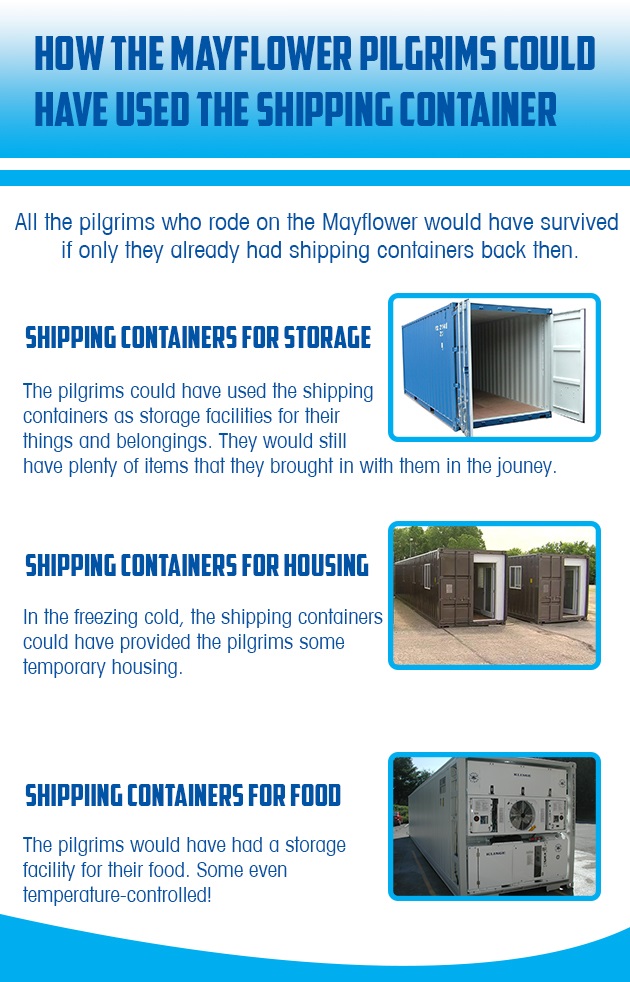
The Pilgrims set sail for England on the Mayflower in July of 1620 but had to restart twice because the other ship that sailed with them was leaking. It didn't officially start until September 6, 1620, and it was a long, stressful journey lasting 66 days. During the voyage, one person fell overboard but luckily other passengers were able to bring him back aboard. Many others became seasick, and one woman, Elizabeth Hopkins, gave birth on the ship.
The Pilgrims arrived at Cape Cod on November 11, 1620, and then they re-located to Plymouth, where they tried to rebuild a town for themselves. This proved challenging as they stayed on the ship at night, while rowing to the location each day to build for several days. Many people became ill and even died before the winter was over from the wet and the cold.
We know that steel shipping containers can house numerous supplies, as well as be used to construct temporary housing so how would these things have helped the Pilgrims aboard the Mayflower?
How Container Ships could’ve Helped the Mayflower Voyage
Since 1956, there have been several container ships able to hold thousands of boxes and crates. The first container ship held only up to 800 tons, but I think the Pilgrims would've even welcomed the extra weight. The biggest ships include the Marco Polo, the Emma Maersk, and the newest ship, the Triple E. These three container ships carry between 16,000 and 18,000 tonnes and measures around 1,300 feet long. In other words, they can carry so much more cargo than the Mayflower originally did, like around 16,000 20-foot steel storage containers, as well as miscellaneous other pallets and boxes. For an interesting visual, you could pack over 8 million cans ok baked beans or tinned meat, which would've provided the Pilgrims an ample amount of food.
More and more shipping and freight is being done by ocean vessels and container ships, in part that cargo ships can hold so much tonnage, and at least 20 million shipping containers are being transported at this minute.
Using Shipping Materials to Provide Temporary Housing
If the Pilgrims travelled to Plymouth by a container ship, loaded with steel shipping containers and wooden pallets, not only would they have enough food to survive, but they'd have materials to build some temporary housing to shield everyone from the cold, winter nights.
Architects Suzan Wines and Azin Valy invented the Pallet House for temporary housing for refugees, something that the Pilgrims would've welcomed. The designers used only wooden pallets so if you carried canned food or other supplies in them, they'd serve a dual purpose. If you didn't bring enough, you can find wooden pallets easily at construction sites or sometimes even the side of the road. If people in your group own some power tools, you can build a small 250-quare foot home, constructed out of 100 pallets in around 5 days. Don't despair though if you don't have power tools with you on this journey as you can still assemble a pallet house with hand tools like a hammer, a crowbar, and nails. Depending on how elaborate you make your pallet house, you can build one as cheap as $500.
The steel shipping containers also can be converted into insulted houses, protecting the Pilgrims from the bitter cold, snow, and rain. Steel shipping containers are not only weather-resistant but strong and durable, making them an ideal choice in disaster situations. In addition, container homes are both modular and expandable, meaning that just like you used to add and subtract Legos from your towers as a child, you can do that easily with shipping containers.
Hopefully, you stored thousands on the cargo ship as you can create a simple 480-square foot apartment out of a 40-foot standard square container. It would contain one bedroom with all the appropriate furnishings as well as a small working kitchen and living room to relax in. In between the two, you can have a bathroom, stocked with all the necessities. You can do them singly or stack up to 16 containers high, making them almost like real high rise apartments. Once you put your own touches on them, it won't feel like a temporary shelter but more like home for the few months you're residing there.
Providing Food for the Pilgrims
While some food items could easily be packed in the wooden pallets or the standard steel shipping containers, other items may spoil on a long journey so you should purchase 100% operational refrigerated storage containers. It's temperature controlled, which keep items like meat or cheeses fresh, and then, you can set up a feeding center on base at Plymouth. You can keep all the cold items in that one container, and serve other high-energy items like canned tuna, biscuits, canned meat, and rice and beans out of another shipping container. These are easy to prepare and will provide energy, especially during the first few weeks as everyone is scrambling to build homes and shelter.
Survival was so much harder almost 400 years ago when the Mayflower sailed. If the Pilgrims travelled today, they'd have so many resources available, such as ways to store food and provide their own housing.

| < Prev | Next > |
|---|




